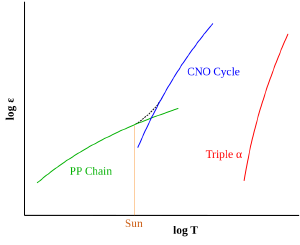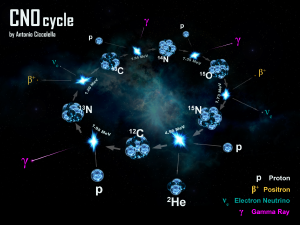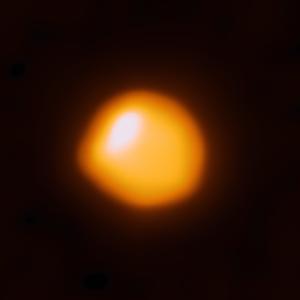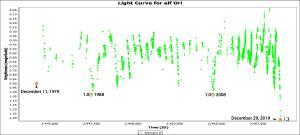Blog
No Boom Today
25 February 2020
The latest observations of Betelgeuse show that the star is now beginning to slowly brighten. No supernova today! Nothing to see, better luck next time.
Despite some of the hype, this behavior is exactly what astronomers expected. Betelgeuse is a very different star from our Sun. While our Sun is a main-sequence star in its prime of life, Betelgeuse is a red giant star on the verge of death. But the death of a star is not a simple process.
 R J Hall
R J HallStars shine so brightly and for so long because of a delicate balance of gravity and nuclear fusion. Gravity would like to collapse a star under its weight. Without nuclear fusion, gravity would crush a star into a white dwarf, neutron star, or black hole. But the crushing pressure gravity creates allows hydrogen in the star’s core to fuse into helium. The process is known as the proton-proton chain (or pp-chain) and combines four hydrogen nuclei into one helium nucleus. About 3% of the original mass is converted to energy in the form of gamma rays. This energy heats the core even further, letting it push back against gravity.
For stars larger than the Sun, another fusion process known as the CNO cycle kicks in. CNO stands for Carbon-Nitrogen-Oxygen because the process fuses helium into those three elements. This process is why those three elements are the most abundant in the universe except for hydrogen and helium.
 Antonio Ciccolella
Antonio CiccolellaWhile both the pp-chain and CNO cycle can occur at the same time within a star, over time the CNO cycle increases as hydrogen become more scarce and helium more abundant. Since the CNO cycle releases more energy at a faster rate than the pp-chain, this means a star’s temperature increases over time. We see this gradual heating in our own Sun. By the time the CNO cycle dominates in a star, it’s core is so hot that the outer layers of a star swell and expand.
This is the stage Betelgeuse is in now. For millions of years, it was a main-sequence star of about 20 solar masses. But it is now fusing helium so furiously that it has bloomed into a red supergiant. Betelgeuse is running out of fuel, and in the end, gravity will win. It’s only a matter of time.
 ALMA (ESO/NAOJ/NRAO) /E. O’Gorman/P. Kervella
ALMA (ESO/NAOJ/NRAO) /E. O’Gorman/P. KervellaBut that time isn’t necessarily soon. Betelgeuse has enough helium to stay in the red supergiant stage for about 100,000 years. Even after it runs out of helium, it will be able to fuse carbon into heavier elements for about a millennium. After that things will change fairly quickly. When it runs out of carbon it will try fusing heavier and heavier elements for about a year. Then its core will collapse, Betelgeuse will become a supernova, and we will finally get our show.
As best we can tell, Betelgeuse is still deep in the red supergiant phase of its life. Even though it has dimmed significantly of recent, it isn’t on the verge of exploding. The gradual dimming and brightening we see suggest that it won’t be exploding in our lifetimes. It suggests that the core of Betelgeuse is still chugging away at a steady pace.
 AAVSO
AAVSOThe changing brightness of Betelgeuse is due to a process known as convection. The upper layers of the star are heated by the core, and this generates a flow of hotter and cooler regions. Material in the interior is heated and rises to the surface. It then cools and sinks into the star, and the cycle continues. Convection happens in the outer regions of most stars, including our Sun. On the surface of the Sun, these convection regions are known as granules, and they are typically the size of Texas. That sounds large, but for the Sun that’s smaller than most sunspots. So even though the Sun has bright hot regions and dimmer cool regions, they are so small compared to the Sun’s surface there isn’t an overall change in solar luminosity.
But the outer layer of Betelgeuse is much less dense than that of the Sun. It is even less dense than Earth’s atmosphere. It’s basically a thin soup of glowing gas. That means the convection regions on Betelgeuse can be huge. A single region can cover a large part of the star. When one of those regions rises to the top, Betelgeuse gets brighter, and when it cools the star dims. Betelgeuse is starting to brighten because hot material is convecting to its surface. This is normal for Betelguese and is likely the way things will be for millennia.
So no boom today. But boom someday. Sooner or later…Boom!